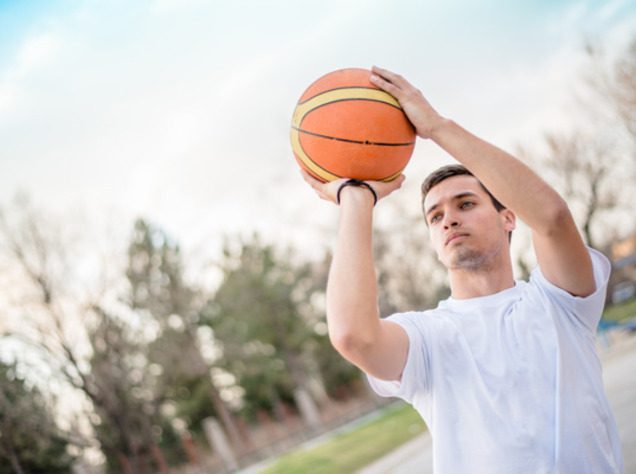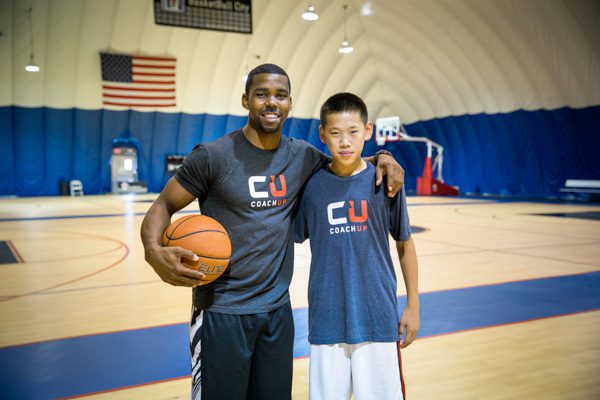Think about the last time you went to the gym to train. What percentage of the time were you actually doing specific drills? And what were you doing instead of those drills? When answering these questions, many players will say they were “shooting around.”
“Shooting around” is the number 1 killer of training productivity. It’s unfocused, lazy, aimless and a waste of time. A focused, 20-minute workout is more productive than two hours of “shooting around.”
I’m not going to preach from my high horse, and pretend like I’ve never been lazy during a workout. I have, and I still occasionally end up “shooting around”. In high school I would go to the gym without a plan or any idea of what I wanted to accomplish. I would jog up and back a few times, dribble around and shoot around aimlessly. I’d trot after missed shots and move at half speed for most of the workout. Even though I was spending two hours at the gym, I wasn’t accomplishing much.
Eventually, with the help of outstanding coaches and mentors, I revamped my workout habits. Once I made the appropriate changes, my game completely transformed. I improved exponentially and would like to share what I learned throughout that process.
The key to eliminating the “shooting around” phenomenon is minimizing decision fatigue. Each decision you make exacts a biological toll. Over time, these decisions eat away at your finite mental resources.
When you’re mentally drained from making a bunch of decisions, one of two things will happen. You’ll act recklessly because you don’t have the mental capacity to fully analyze your decision, or you’ll avoid making a decision at all to save energy. This second energy-saving technique is what leads to “shooting around.” To ease your mental strain, you avoid deciding what drill to do, for how many reps, etc. You’ll end up aimlessly floating around the court wasting time, “shooting around.”
Humans have a limited amount of willpower. Once it is used up, succumbing to temptation becomes easier. In this case, the temptation is to ease up on your workout takes over. You can’t rely on your willpower to consistently create great workouts. It simply doesn’t work. So, if minimizing decision fatigue is how we can avoid “shooting around,” how do we do it?
Five ways to stay focused and avoid “shooting around” syndrome
1) Create a workout plan for each training session
A workout plan should have 3 factors:
1. A list of each drill you will do
2. how many reps (or time) you will do each drill
3. the length of rest time in between each drill
Be as specific as possible. Instead of writing “Stationary Ball Handling,” include the exact exercises within that drill. For example, “Stationary Ball Handling: crossovers, between the legs, behind the back, double crossovers, killer crossover. (20 seconds on, 10 seconds rest, x2)” This level of specificity eliminates any indecision and allows you to focus all your willpower on working hard.
Your workout plan must be followed religiously. Not fully committing to each workout plan defeats the purpose. If you have to decide whether or not to do each drill on your workout plan, you’ll still be making unnecessary decisions and fatiguing your mind.
2) Workout early in the day
Even mundane daily decisions can be a drain on your willpower. What clothes to wear, what to have for breakfast, whether to watch a youtube video or go on Facebook, what to order on your burrito, etc. By the end of the day, you’ve made so many decisions and analyzed so many trade-offs that you’re mentally exhausted.
This is why even the people with the strongest willpower can struggle with their weight. They may be able to refuse sugary cereals and pastries in the morning but by the time night rolls around, it’s hard to ignore the tasty looking tub of cookie dough ice cream.
If you can do your workouts in the morning, your brain will be fresh and your willpower fully stocked.
3) Do your least favorite exercises first
I despise pure ball handling drills, so I’ve made a concerted effort to get them out of the way first. I’ve actually created an entirely separate workout for my ball handling drills that I do in the mornings. That way I can’t delay them until the end of the workout where I end up ignoring them. During these morning workouts I don’t shoot a single shot; this way I’m not tempted to begin shooting around (which I enjoy much more).
Sidenote: if you don’t like a certain drill, there’s a good chance it’s exactly what you need.
4) Take a hit of sugar
Now I don’t recommend crushing a king size Snickers before a workout, but glucose has been shown to restore willpower. If you’re feeling exhausted or just had a long day, a small dose of glucose can give your mind the pick me up it needs.
Fruits like oranges, apples and bananas are great options. But Gatorade, Vitamin Water, Power Bars and Clif Bars will do the trick too.
5) Develop Workout Habits
I’ve talked at length about the power of habits and how to develop them in previous posts, so I’ll keep it brief. The idea is that habits eliminate the necessity for decisions because they are automatic responses. By developing workout habits, you conserve your precious willpower. Instead of deciding whether or not to force yourself to train today, find a workout partner and schedule consistent workout times.
“Shooting around” is the number 1 killer of workout productivity. By following these five tips you can avoid “shooting around” and create purposeful and productive training sessions.

With our 100% money-back guarantee and vetted coaches, anyone can achieve their full athletic potential. CoachUp is the safest and easiest way to find a coach for personalized training. Find your perfect coach today and become the athlete you want to be!
How useful was this post?
Click on a star to rate it!
Average rating 5 / 5. Vote count: 4
No votes so far! Be the first to rate this post.



